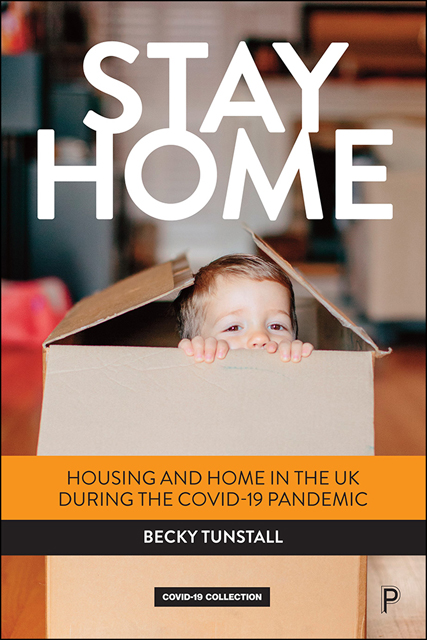Book contents
- Frontmatter
- Contents
- List of figures, tables and photos
- Acknowledgements
- 1 COVID-19, housing and home
- 2 UK households and homes before the pandemic
- 3 The pandemic and pandemic policy in the UK
- 4 People, households and time at home in the pandemic
- 5 The role of household and home in COVID-19 infection and death
- 6 Being vulnerable or ill at home in the pandemic
- 7 The impact of COVID-19 and COVID-19 policy on incomes, housing costs and housing security
- 8 The impact of COVID-19 and COVID-19 policy on the housing market
- 9 Summary and conclusions
- Appendix: The data from people aged 19, 31, 50, 62 and 74
- Notes
- References
- Index
9 - Summary and conclusions
Published online by Cambridge University Press: 20 June 2023
- Frontmatter
- Contents
- List of figures, tables and photos
- Acknowledgements
- 1 COVID-19, housing and home
- 2 UK households and homes before the pandemic
- 3 The pandemic and pandemic policy in the UK
- 4 People, households and time at home in the pandemic
- 5 The role of household and home in COVID-19 infection and death
- 6 Being vulnerable or ill at home in the pandemic
- 7 The impact of COVID-19 and COVID-19 policy on incomes, housing costs and housing security
- 8 The impact of COVID-19 and COVID-19 policy on the housing market
- 9 Summary and conclusions
- Appendix: The data from people aged 19, 31, 50, 62 and 74
- Notes
- References
- Index
Summary
This chapter returns to the key questions set out in Chapter 1.
1) How prepared was the UK housing system for the COVID-19 shock
The UK housing system, its homes and households were not prepared for the COVID-19 shock, because no UK institutions or sectors were prepared, including central government and the NHS. The explanations for this are dealt with in more detail elsewhere.
When the pandemic struck, more people in the UK had the spacious homes that would enable safe and comfortable staying home, shielding and isolating than in many other countries in Europe and the world. Nonetheless, many did not have the right homes to shield and isolate successfully.
Before the pandemic, four housing problems were getting worse and were a source of inequality between income groups, ethnic groups and tenures: overcrowding, unaffordability (and low disposable income after housing costs), insecurity and homelessness.
UK households had high rates of employment, but large proportions of households were paying housing costs from work income that was insecure in normal times or about to become so, many households had no savings and the housing safety net had been weakened. A total of 22% of the population was in poverty after housing costs, and destitution and foodbank use were at record levels.
Before the pandemic, a housing ‘crisis’ for people on low incomes, some renters, hidden households and homeless people coexisted with good conditions affordability and equity growth for many. In normal times, overcrowding, unaffordability, insecurity and homelessness could be seen as problems of welfare, wellbeing and justice. In the pandemic, these were even more significant: they could expose those affected and others to risk of infection and death, as well as to the effects of abnormal income shocks.
In some senses, the UK political, economic and housing systems were more resilient to the income and GDP shock from the pandemic in 2020 than they had been at the time of the GFC in 2008, because of the experience gained at that time and reforms carried out afterwards. However, one lingering result of the GFC was that the UK government perceived the emergency role of housing policy as a tool for emergency economic policy rather than as a source of public health, living standards and wellbeing.
- Type
- Chapter
- Information
- Stay HomeHousing and Home in the UK during the COVID-19 Pandemic, pp. 177 - 185Publisher: Bristol University PressPrint publication year: 2022



